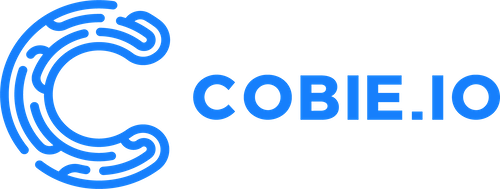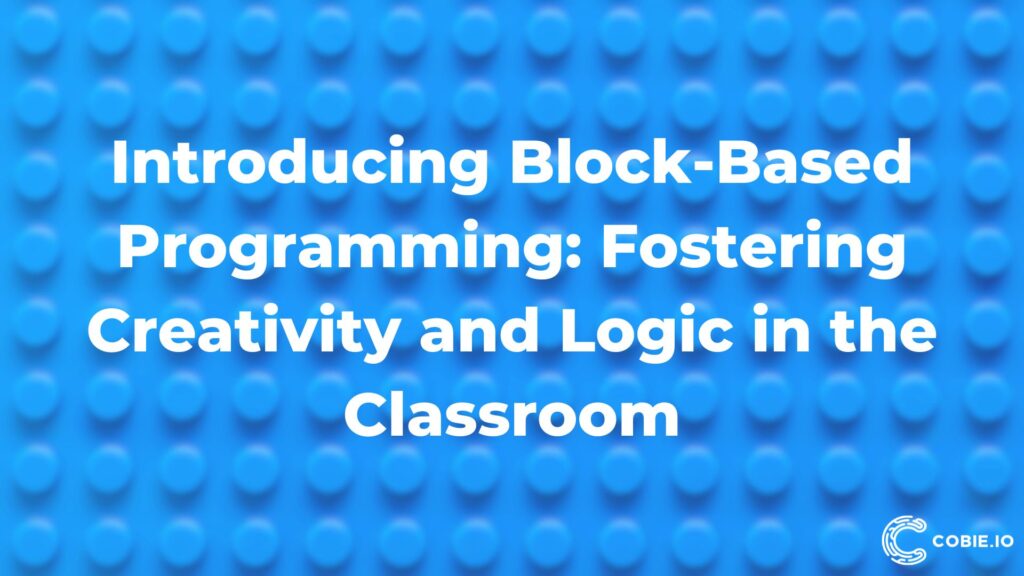
Introducing Block-Based programming to the students will bring a lot of benefits to your curriculum.
Block-based programming is a visual way of coding that uses “blocks” or puzzle-like pieces to create programs. Instead of typing lines of code, learners can drag and drop blocks that represent various programming commands and logic. This approach removes the complexity of syntax and allows beginners to focus on understanding the fundamental principles of coding.
As we at Cobie AI develop our smart classroom block-based programming is the first language skill we offer. We think block-based programming is a great way to introduce coding to your students.
Here are the steps you can take as a teacher when introducing block-based programming into your classroom:
- Quic introduction, what is block-based programming
- Explain benefits of using block-based coding
- Choose creative and interactive projects
- Using block-based coding visual aspect to Teach and explain coding concepts
- Show some Real-life examples of how block-based programming has helped students learn coding; it’s always great for students to know what previous generations created
- Address common challenges and misconceptions about block-based programming
- Introduce collaboration and teamwork in block-based programming projects
- Promote creativity and problem-solving skills
- Preparing students for transitioning from block-based programming to text-based languages. It’s important to show students how to use their knowledge in other programming languages.
By manipulating blocks and observing how they interact with each other, students develop an understanding of algorithms, loops, conditionals, and variables, which are the building blocks of programming.
Block-based programming also encourages collaboration and peer learning. Students can share their projects, remix and modify each other’s work, and provide feedback within the online community. This collaborative aspect fosters a supportive and inclusive learning environment where students can learn from one another and gain inspiration from different perspectives.
In addition, block-based programming helps learners develop a sense of accomplishment and confidence in their coding abilities. The immediate visual feedback and the ability to see their projects come to life motivates students to explore and experiment with coding concepts further.
Benefits of using block-based programming for teaching coding

With the introduction of block-based programming you will significantly lower the barriers to entry for programming education. It offers a more accessible and engaging learning experience, especially for young learners with little or no prior coding experience.
The visual nature of block-based coding makes it easy to understand and more tangible, enabling students to grasp programming concepts more effectively. Moreover, block-based programming promotes essential computational thinking skills such as problem-solving, logical reasoning, and creative thinking
Block-based programming languages offer several benefits when it comes to teaching coding to beginners. These languages, characterized by their visual interface and drag-and-drop functionality, provide a more accessible and engaging introduction to programming concepts.
Let’s explore some of the key benefits of using block-based programming in the classroom:
- Visual Representation: Block-based programming utilizes visual blocks to represent code commands, making it easier for students to understand the logic and structure of a program. By visually connecting the blocks together, students can easily comprehend how different elements of code work together to achieve a desired result. This visual representation helps develop a solid foundation of coding concepts.
- Instant Feedback: Block-based coding environments often provide immediate feedback, allowing students to quickly identify and correct errors in their code. This immediate feedback loop helps foster iterative learning, where students can experiment with different solutions, identify mistakes, and refine their code in real-time. This instant feedback nurtures a growth mindset by encouraging students to learn from their mistakes and persist in problem-solving.
- Reduced Syntax Complexity: Traditional text-based programming languages require a precise syntax that can be intimidating for beginners. Block-based programming simplifies this aspect by eliminating the need to memorize specific syntax rules. Instead, students can focus on understanding programming concepts and how to implement them effectively, without worrying about syntax errors.
- Engaging and Interactive: The drag-and-drop nature of block-based programming makes it highly interactive and engaging for students. They can physically manipulate blocks to create interactive projects, animations, and games, providing a hands-on learning experience. This interactivity increases motivation and keeps students actively engaged throughout the coding process.
- Inclusive Learning Environment: Block-based coding caters to different learning styles and abilities. The visual nature of the language allows students to express their ideas and demonstrate their understanding of programming concepts in a non-verbal way. This inclusivity fosters a collaborative and supportive learning environment, where students can work together, exchange ideas, and celebrate each other’s achievements.
Seamless Transition to Text-based Languages: Block-based programming serves as a stepping stone towards text-based programming languages. By starting with visual blocks that represent code commands, students grasp the fundamental concepts of programming before having to deal with complex syntax. This gradual progression enables a smoother transition to text-based languages later on, as students already have a solid foundation of programming logic.
Exploring different block-based programming languages for education
When it comes to teaching coding using block-based programming, educators have a wide range of options to choose from. Various programming languages have been specifically designed to make coding more accessible and beginner-friendly, allowing students to learn fundamental coding concepts without getting caught up in syntax errors or complex syntax rules.
One of the most popular block-based programming languages for education is Scratch. Developed by the Lifelong Kindergarten Group at the MIT Media Lab, Scratch simplifies coding by using intuitive drag-and-drop blocks that snap together like puzzle pieces. With Scratch, students can easily create interactive stories, animations, and games by stacking blocks that represent different coding instructions. Read our article to learn more about why us Scratch in classroom
Another noteworthy block-based programming language for education is Blockly. Developed by Google, Blockly provides a visual programming editor that can be integrated into various educational platforms. Blockly is highly versatile and allows students to learn coding concepts in a fun and engaging way. With its intuitive interface, students can drag and drop blocks to build their programs and see immediate results. It was also used as a base to develop the Scratch environment.
Snap! is another powerful block-based language that offers more advanced features and functionalities. It is an extension of Scratch and adds additional capabilities such as custom blocks and user-defined procedures. Snap! is suitable for students who have mastered the basics of coding with Scratch and are ready to explore more complex programming concepts.
For educators looking to introduce younger students to coding, there is also a block-based programming language called Code.org’s Code Studio. Code.org offers a curriculum that includes a series of coding lessons using block-based programming. The platform features engaging and interactive activities that progressively introduce coding concepts to students in a beginner-friendly way.
In addition to these popular options, there are several other block-based programming languages available, each with its unique features and targeted audience. BlocklyDuino, for example, combines the visual programming aspect of Blockly with Arduino hardware, allowing students to program physical devices using blocks. App Inventor is another block-based programming tool that focuses on creating mobile apps for Android devices.
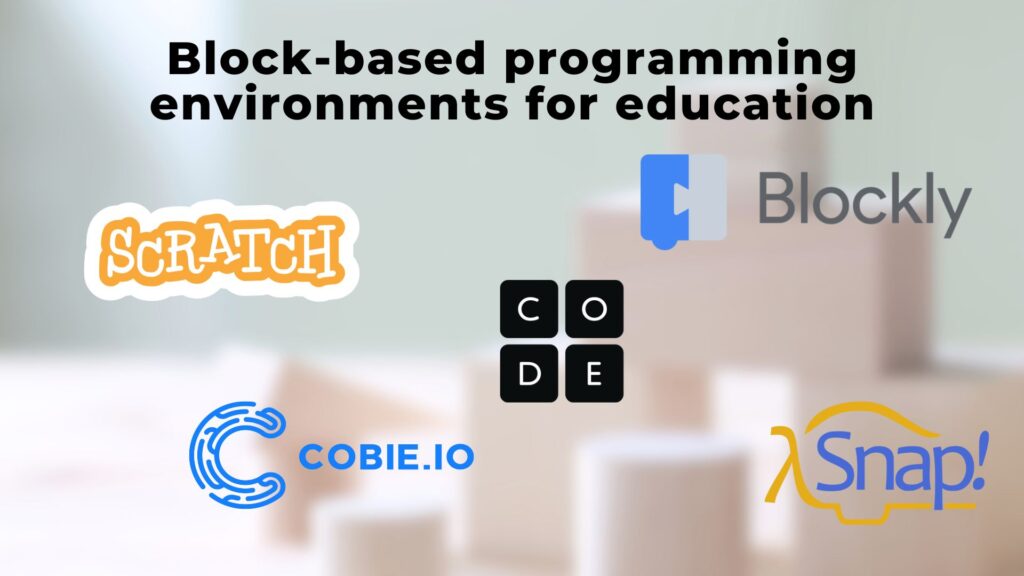
Exploring different block-based programming languages allows educators to find the best fit for their teaching needs and student population. It’s important to consider factors such as the age group, learning objectives, and available resources when choosing a programming language for the classroom. By selecting the right language, educators can create an engaging and effective learning environment for teaching coding.
Are there specific block-based programming platforms or tools that are recommended for classroom use?
Great place to start is Scratch and nowadays almost a de facto standard based on usage by teachers, if you do not know where to start this is a good place to start, if you only need to bring creative and interactive project to the classroom and show how fun computer science can be I can not suggest better start.
But if you need more information as a teacher on what your students are doing and how to help them, if you want to use integrated communication, we would suggest using Cobie AI smart classroom where we use Google Blockly as a base to show programming concepts. But we also offer tools for teachers to see what the students are doing in real-time, overviewing their code, we offer suggestions based on there code in real time and we have a lot of lesson plans ready to use, so apply for a demo and we will show you how it works within Cobie AI smart classroom. Cobie AI is also great when you want to bring a student’s knowledge even to a higher level with ability to show transition to text-based programming languages working on web projects with students and much more.
What are the best practices for introducing block-based programming to students who are new to coding? – Getting started
Introducing block-based programming in the classroom:
- Selecting the right platform: There are several block-based programming languages and platforms available, such as Scratch, Blockly (and Cobie AI smart classroom 😉), and App Inventor. As a teacher, it’s essential to choose the platform that aligns with your teaching goals and curriculum.
- Providing resources and tutorials: Offer students access to tutorials, examples, and resources to help them get started with block-based programming. Online platforms often provide introductory tutorials and step-by-step guides to help students navigate through the interface and create their first projects.
- Hands-on activities: Encourage students to explore the different blocks and experiment with their functionalities. Start with simple projects, such as creating animations or games, and gradually increase the complexity as students gain confidence and proficiency.
Integrating block-based programming with other subjects: Consider integrating block-based programming into other subjects, such as math or science, to demonstrate real-world applications of coding. This interdisciplinary approach helps students see the practical relevance and enhances their understanding of both coding and the subject being taught.
Creating interactive projects using block-based programming
Creating interactive projects is one of the exciting ways to engage students in coding using block-based programming. With the visual interface teachers can encourage their students to create great projects that showcase their coding skills.
Let’s explore some ideas on how to get started with creating interactive projects when you introduce block-based programming into your curriculum.
1. Game Development: Block-based programming languages offer a great platform to introduce students to the world of game development. Students can design and create their own interactive games by adding characters, backgrounds, and game mechanics using blocks. They can experiment with different game genres such as platformers, puzzles, or even simple simulations. By designing games, students get hands-on experience in programming logic, problem-solving, and creative thinking.
Examples for game development: A game where the player controls a character to jump over obstacles and reach the finish line, a game where the player must solve a series of challenges to progress, a game that teaches students about a particular topic (especially good for schools and connection to other subjects).
2. Animation and Storytelling: Another exciting way to utilize block-based programming is by enabling students to create animated stories or movies. Students can develop their storytelling and design skills by using blocks to create characters, animate their movements, and add dialogues. They can also experiment with special effects, sound effects, and background music to bring their stories to life. This not only enhances their coding abilities but also nurtures their creativity and communication skills.
Examples for animation: film about a particular story that happened in school, animation that tells a story frame by frame, interactive story where the user can choose the outcome of the story…
3. IoT (Internet of Things) Projects: Block-based coding languages can be combined with hardware platforms like Micro:bit, Raspberry Pi to create interactive projects. In this kind of project students can learn how to control physical devices, such as LEDs, sensors, or motors, by using blocks to program their behavior.
Examples for IoT: counter for number of jumps using gyroscope sensor, light sensor to turn on a light when it gets dark, motion sensor to activate a camera, temperature sensor to control the temperature of a room, speaker to play a sound when a certain event occurs.
4. Mobile Apps: Many block-based programming platforms provide extensions or tools to create mobile applications. Students can develop their own apps by utilizing blocks to design user interfaces, add functionalities, and incorporate multimedia elements.
Examples for mobile apps: quiz app, a language learning tool, or a virtual art gallery…
What strategies can I use to keep students engaged and motivated while learning with block-based programming?
By encouraging students to create interactive projects using block-based programming, teachers can not only make coding accessible but also foster collaboration, critical thinking, and innovation. These projects serve as tangible evidence of their progress, boosting their confidence and motivation to further explore the world of coding.
Using block-based programming to teach specific coding concepts
When it comes to teaching coding, one of the challenges teachers often face is helping students grasp complex programming concepts. However, with the advent of block-based programming languages, educators now have a powerful tool at their disposal. Block-based programming allows students to explore and understand coding concepts in a visual and interactive way, making it easier for them to learn and apply their knowledge.
Understanding the Basics: Variables and Loops
Beginners often struggle with understanding variables and loops in coding. These fundamental concepts serve as building blocks for more complex programs. We can provide a nice introduction to variables and loops by visually representing them as puzzle pieces that can be easily connected and manipulated.
Conditional Statements: If-Else Logic
Teaching conditional statements, particularly if-else logic, can be quite challenging. With the ability to easily change parameters and experiment with different scenarios, students can gain a solid understanding of how if-else statements work and how they influence program flow.
Event-Driven Programming: Interactivity and Events
Introducing event-driven programming can be both exciting and complex. Block-based programming shines in this area by enabling students to create interactive projects that respond to various events such as button presses, mouse movements, or key inputs.
Object-Oriented Programming: Building Objects and Classes
Block-based programming allows students to create and manipulate graphical objects, providing a hands-on introduction to the base principles of object-oriented programming. By connecting blocks representing object properties and methods, students can grasp the fundamental concepts of what an object is. Teachers can use opportunities to explain that when they are setting values they are working with objects.
Integrating block-based programming into existing coding curriculum
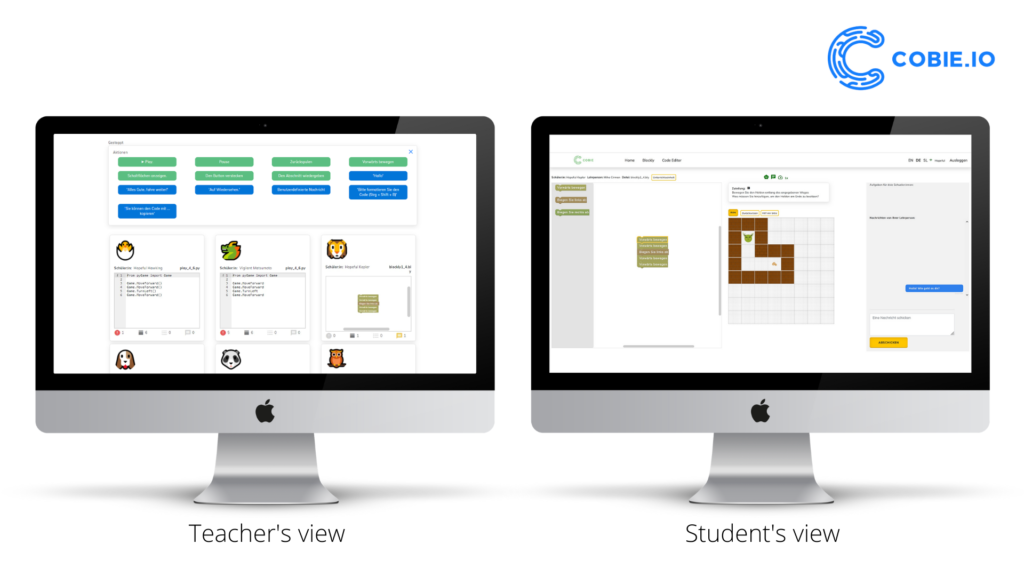
Cobie AI excels in this area. As we have a great number of lessons for block-based programming, teachers can use our system out of box with our embedded lesson plan. Teachers will get lectures (voice, text, images…) that they can use to carry out their lessons. Students will be able to work with our assignments and acquire new knowledge. Check our smart classroom and apply for a demo. We also offer all the infrastructure in the cloud so no installation is required. We also take great care of data protection, so that students and teachers can use our platform without any concern for their personal data.
Addressing common challenges and misconceptions about block based programming
1. Block-based coding is only for kids: While block-based coding is beginner-friendly and suitable for introducing coding to young learners, it’s also a powerful tool used by professionals in various industries.
2. Block-based programming languages are not a real programming language: Block-based programming languages are indeed real programming languages. They offer a visual and intuitive way to write code, making it easier to understand and learn programming concepts.
3. Block-based coding is too simple: Block-based coding may seem simple at first, but it can be tailored to teach intricate programming concepts. It’s a versatile tool that helps students grasp fundamental coding logic before transitioning to more complex languages. Even skilled programmers can use block-based languages for prototyping and rapid development.
4. Block-based programming is only for playing games: Block-based programming has a wide range of applications beyond games. It’s used in education, scientific simulations, data visualization, and more. While it can be fun and engaging, it’s a legitimate way to develop practical skills that extend far beyond gaming.
Collaboration and teamwork in block based programming projects
We are really proud that we can offer this layer of learning within our platform. As of this year we can offer working in pairs for students, where students can develop their coding skills, but most importantly they also develop soft skills and better communication with their partners, and colleagues.
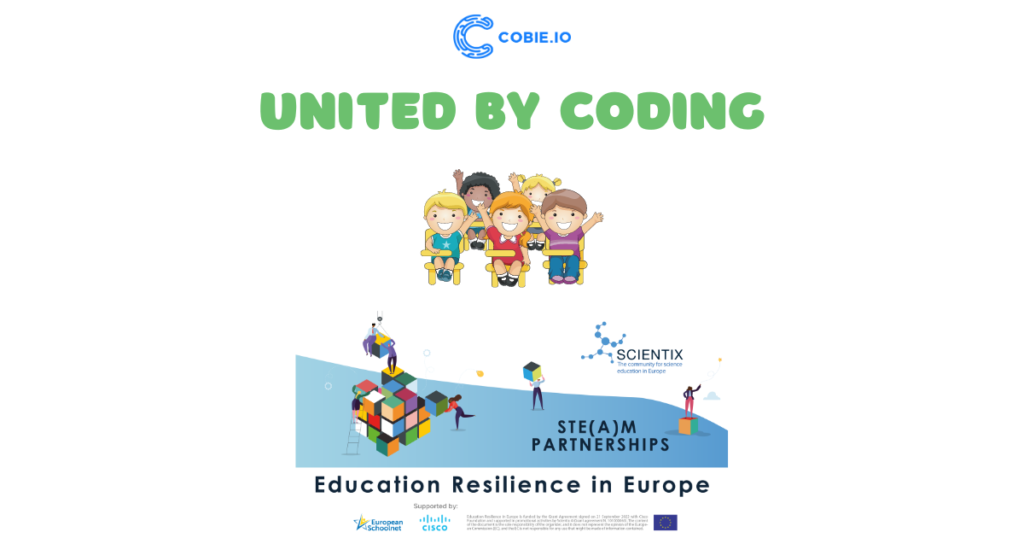
This major addition was a part of the United By Coding project. Where we worked in collaboration with EUN to develop a framework for better inclusion of students migrating all over Europe. Project was a great success and teachers loved the outcomes in social skills that students build. Read more about the United By Coding project.
Preparing students for transitioning from block based programming to text-based languages:
After introducing block-based programming in the classroom and when students become comfortable with it, it is important to prepare them for the transition to text-based languages. While block-based programming offers a visual and intuitive approach to coding, text-based languages provide a more robust and versatile programming experience. Here are some suggestions for effectively preparing students for this transition:
- Introduce syntax principles: Start by explaining the fundamental principles of syntax in programming. Teach students about variables, loops, conditionals, and functions in a text-based language context. Emphasize the importance of precise syntax and the need for proper structure in writing code.
- Gradual exposure: Gradually introduce students to text-based coding environments while allowing them to continue using block-based languages as scaffolding. Encourage them to explore hybrid environments that combine visual blocks with textual coding elements. This helps bridge the gap between the two approaches and eases the transition.
- Practice with code snippets: Provide students with short code snippets written in a text-based language and ask them to analyze and predict the output or behavior of the code. This exercise helps familiarize students with the syntax and logical flow of text-based languages.
- Collaborative coding: Encourage students to work in pairs or small groups to collaboratively write code in a text-based language. This promotes peer learning and enables students to support and learn from each other’s experiences. It also boosts their confidence and helps develop problem-solving skills.
- Offer syntax references: Provide students with quick reference guides or cheat sheets that outline the syntax rules and common programming constructs in text-based languages. These references can serve as handy tools for students to consult as they transition to working with text-based code.
- Engage in hands-on projects: Assign projects that require students to implement their coding concepts in text-based languages. This allows them to apply their block-based programming knowledge while progressively adapting to the use of textual code. Encourage creativity and critical thinking by giving students the freedom to explore different approaches to solving problems.
- Emphasize debugging skills: Text-based programming often requires meticulous debugging to identify and fix errors. Teach students how to effectively debug code by analyzing error messages, using print statements, and stepping through code execution. Debugging skills are crucial for students to become proficient in any programming language.
- Provide resources and support: Offer a variety of resources, such as online tutorials, coding exercises, and forums, to support students during the transition. Encourage them to leverage these resources to deepen their understanding and seek assistance when needed.
By following these strategies and providing a supportive learning environment, educators can effectively prepare students for transitioning from block-based programming to text-based languages. This smooth transition ensures that students can continue to grow and expand their coding skills, preparing them for advanced programming concepts and future endeavors.
Preparing students for transitioning from block-based programming to text-based languages:
Preparing students to smoothly transition from block-based programming to text-based languages is a crucial aspect of our approach at Cobie AI. We firmly believe that mastering algorithmic thinking is a fundamental skill that students cultivate while learning to code with block-based languages. This belief is a base for our methodology, which empowers students to seamlessly apply their existing knowledge to embark on their coding journey with text-based languages.
In our methodology, continuity is key. We facilitate a seamless progression by employing consistent keywords and function names and problem-solving environments across both block-based and text-based programming. This ensures that students remain within a familiar “ecosystem”, allowing them to seamlessly extend projects initiated in block-based programming. Even when transitioning to text-based programming, students can engage in captivating activities like game-playing and puzzle-solving that they’ve become accustomed to.
It’s worth highlighting the remarkable effectiveness of our approach. Even students who were initially concerned about text-based programming have found themselves eagerly learning Python, thanks to our methodology’s ability to sustain their engagement and enthusiasm.
Furthermore, our cloud-based infrastructure eliminates installation concerns, contributing to an even smoother transition process.
Conclusion
Introducing Block-based programming and using it to show what programming isoffers a bridge between abstract coding concepts and hands-on learning. By using visual elements and intuitive puzzle-like blocks, students can gain a solid foundation in coding principles and develop problem-solving skills. By incorporating block-based programming into the classroom, teachers can effectively teach specific coding concepts and inspire students to explore the world of programming with confidence and enthusiasm.
